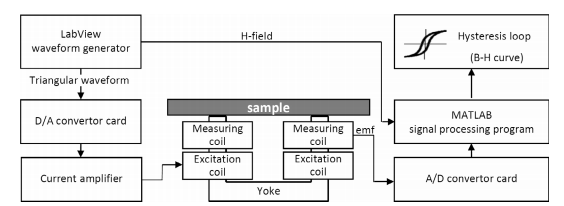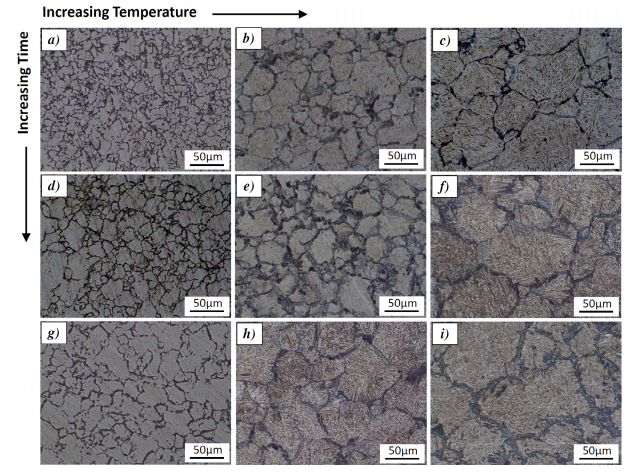【摘要】 奥氏体化作为大多数热处理工艺的第一步,是将钢加热到临界温度以上,并在给定时间内将其浸泡以发生相变。
奥氏体化作为大多数热处理工艺的第一步,是将钢加热到临界温度以上,并在给定时间内将其浸泡以发生相变。奥氏体化阶段的时间和温度是控制钢在淬火和回火状态下最终组织和力学性能的重要因素。时间或温度不足导致富碳区域转变为马氏体相,而碳含量较少的区域转变为贝氏体等不需要的相[1]。相反,延长时间和温度会导致其他不必要的微观结构变化,如晶粒生长[2,3]和脱碳[4,5]。在奥氏体化和淬火过程中,先前的奥氏体晶粒尺寸是影响马氏体形态[6]、马氏体板尺寸[7]、马氏体起始(Ms)温度[8,9]等特征的最重要的微观结构特征之一,奥氏体-马氏体转变动力学[10]和位错密度[2]。研究表明,由于奥氏体化温度或时间(在很大程度上)和钢成分(在较小程度上)的变化,先前的奥氏体晶粒尺寸发生了改变[11]。

图一 磁滞回线测量系统的原理框图
因此,在热处理钢零件的质量控制和检验过程中,测量和监测初生奥氏体晶粒尺寸至关重要。传统的测量奥氏体晶粒度的方法是通过光学/电子显微镜进行金相观察,这种方法具有破坏性、昂贵且耗时。此外,定量测定原始奥氏体晶粒尺寸并不像铁素体晶粒尺寸那么容易。需要特殊的蚀刻剂和蚀刻方法,如化学蚀刻[12]、氧化蚀刻[13]和热蚀刻[14,15],以使先前的奥氏体晶界出现;因此,这些方法很难用于工业规模。

图二 a)在950℃下奥氏体化0.5 h,b)在1000℃下奥氏体化0.5 h,C)在1050℃下奥氏体化0.5 h,d)在950℃下奥氏体化1.0 h,e)在1000℃下奥氏体化1.0 h,f)在1050℃下奥氏体化1.0 h,g)在950℃下奥氏体化1.5 h,h)在1000℃下奥氏体化1.5 h,i)在1050℃下奥氏体化1.5 h。
然而,巴克豪森噪声(BN)、涡流(EC)和磁滞回线(HP)等电磁无损检测技术可以有效地将晶粒尺寸与电磁特性关联起来,并对其进行定量测定。表征基于晶界处闭合畴的形成,这为磁化期间畴壁的运动提供了障碍,从而影响电磁特性。但表征钢样品晶界的无损检测(NDE)主要集中在铁素体相。例如,Rumiche等人[16]研究了普通碳钢中铁素体晶粒尺寸与磁滞回线参数之间的关系。Anglada Rivera等人[17]研究了晶粒尺寸变化对商用1005碳钢磁滞回线特性的影响。Tanner等人[18]报告了矫顽力和磁导率之间的线性关系。
参考文献
[1] P.M. Unterweiser, Heat treater’s guide: standard practices and procedures for steel, ASM Int. (1982).
[2] Y. Prawoto, N. Jasmawati, K. Sumeru, Effect of prior austenite grain size on the morphology and mechanical properties of martensite in medium carbon steel, J. Mater. Sci. Technol. 28 (2012) 461–466.
[3] S. Liu, Y. Chen, G. Liu, X. Liu, Y. Zhang, J. Huang, Microstructure evolution of medium carbon steel during manufacture process for non-quenched and tempered oil well tubes, Mater. Sci. Eng. A 499 (2009) 83–87.
[4] S. Kahrobaee, M. Kashefi, A.S. Alam, Magnetic NDT Technology for characterization of decarburizing depth, Surf. Coat. Technol. 205 (2011) 4083–4088.
[5] Y. Prawoto, N. Sato, I. Otani, M. Ikeda, Carbon restoration for decarburized layer in spring steel, J. Mater. Eng. Perform. 13 (2004) 627–636.
[6] B. Białobrzeska, Ł. Konat, R. Jasiński, The influence of austenite grain size on the mechanical properties of low-alloy steel with boron, Metals 7 (2017) 26.
[7] J. Guimaraes, A. Saavedra, The mean size of plate martensite: influence of austenite grain size, partitioning, and transformation heterogeneity, Metall. Trans. A 16 (1985) 329–336.
[8] J. Guimarães, P. Rios, Martensite start temperature and the austenite grain-size, J. Mater. Sci. 45 (2010) 1074.
[9] H.-S. Yang, H. Bhadeshia, Austenite grain size and the martensite-start temperature, Scr. Mater. 60 (2009) 493–495.
[10] Y.F. Titovets, N.Y. Zolotarevskii, A. Samoilov, G. Hribernig, A.Y. Kraevskii, A. Pichler, Simulation of the effect of austenite grain size scattering on the kinetics of the γ→ α transformation, Met. Sci. Heat Treat. 52 (2010) 67–74.
[11] S. Zhang, M. Li, Y. Liu, J. Luo, T. Liu, The growth behavior of austenite grain in the heating process of 300M steel, Mater. Sci. Eng., A 528 (2011) 4967–4972.
[12] L. Zhang, D.C. Guo, A general etchant for revealing prior-austenite grain boundaries in steels, Mater. Charact. 30 (1993) 299–302.
[13] G.F. Vander Voort, Metallography, Principles and Practice, ASM International, 1984.
[14] C.G. De Andres, M. Bartolomé, C. Capdevila, D. San Martın, F. Caballero, V. López, Metallographic techniques for the determination of the austenite grain size in medium-carbon microalloyed steels, Mater. Charact. 46 (2001) 389–398.
[15] C.G. de Andrés, F. Caballero, C. Capdevila, D. San Martın, Revealing austenite grain boundaries by thermal etching: advantages and disadvantages, Mater. Charact. 49 (2002) 121–127.
[16] F. Rumiche, J. Indacochea, M. Wang, Assessment of the effect of microstructure onthe magnetic behavior of structural carbon steels using an electromagnetic sensor, J. Mater. Eng. Perform. 17 (2008) 586–593.
[17] J. Anglada-Rivera, L. Padovese, J. Capo-Sanchez, Magnetic Barkhausen noise and hysteresis loop in commercial carbon steel: influence of applied tensile stress and grain size, J. Magn. Magn. Mater. 231 (2001) 299–306.
[18] B. Tanner, J. Szpunar, S. Willcock, L. Morgan, P. Mundell, Magnetic and metallurgical properties of high-tensile steels, J. Mater. Sci. 23 (1988) 4534–4540.
科学指南针通过互联网技术建立更可靠的服务标准,全国26个办事处,12个城市拥有自营实验室,最好的设备、最专业的老师为您服务。
免责声明:部分文章整合自网络,因内容庞杂无法联系到全部作者,如有侵权,请联系删除,我们会在第一时间予以答复,万分感谢。











 您已经拒绝加入团体
您已经拒绝加入团体

 2022-03-14
2022-03-14
 4972
4972
 0
0










